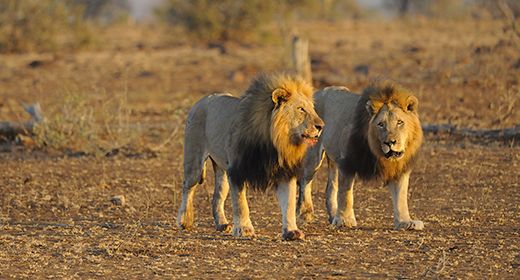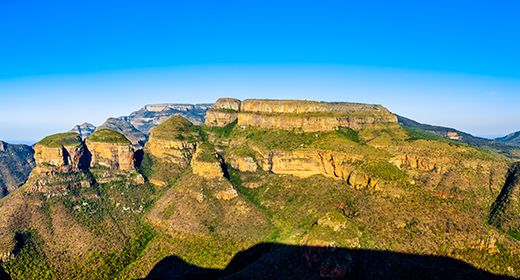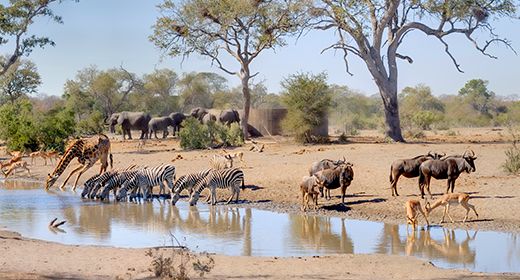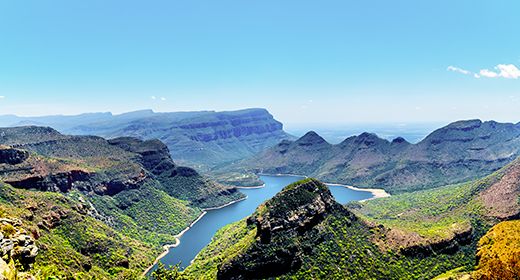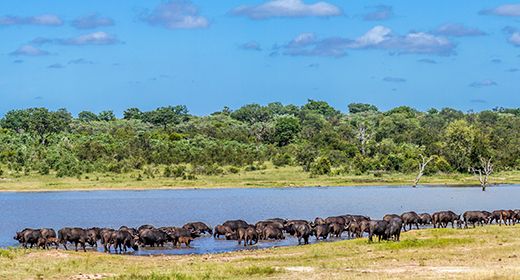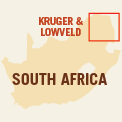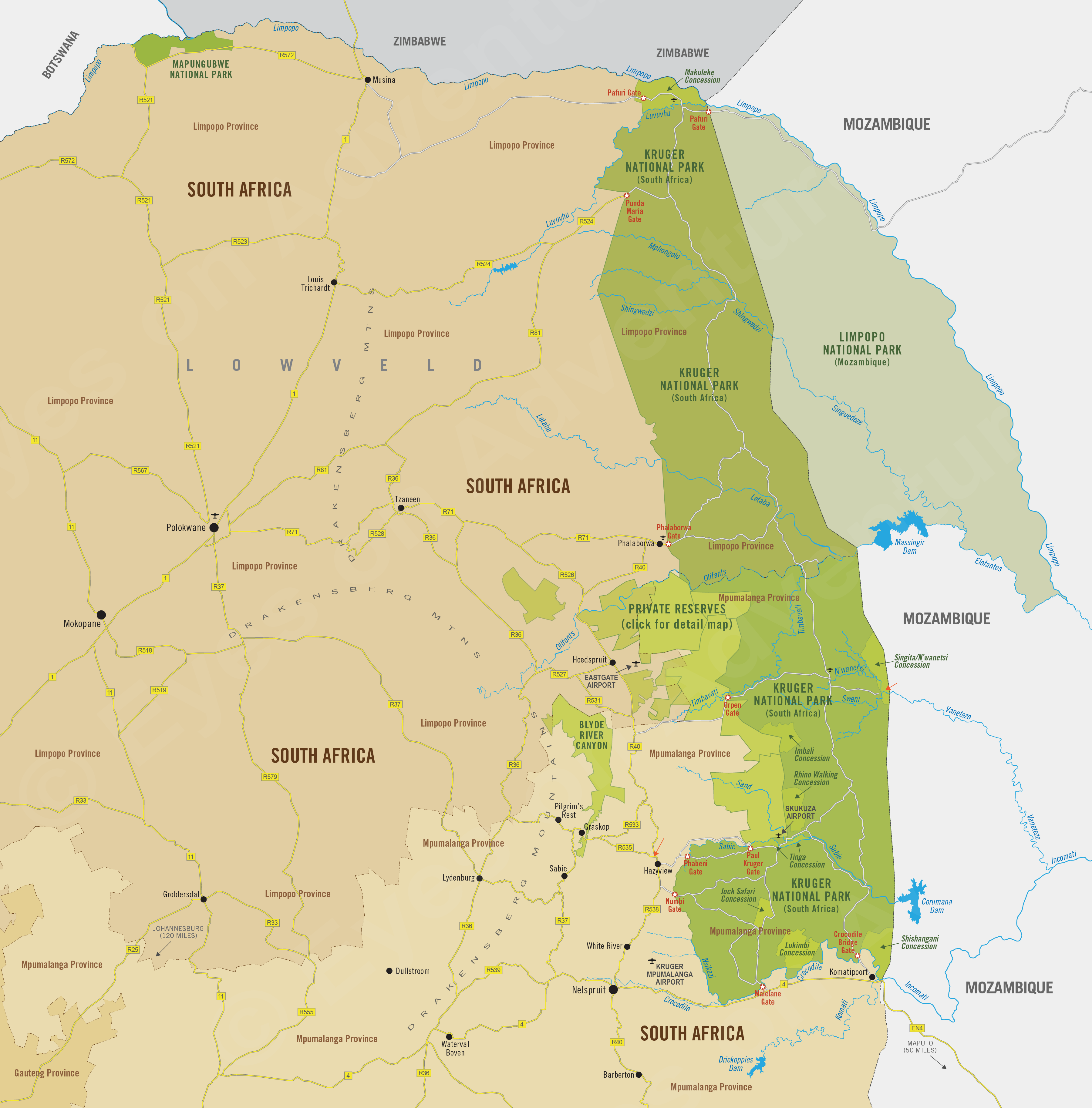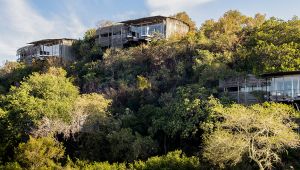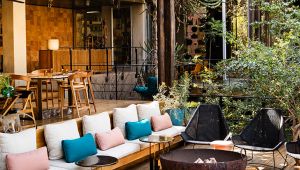Kruger Park & Lowveld
(incl. Kruger National Park, White River, Hazyview, Drakensberg Mountains)
Region Links: Cape Peninsula, Cape Town, Cape West Coast, Cape Winelands, Eastern Cape, Garden Route, Gauteng Province, Johannesburg, Kruger Park & Lowveld, Kruger Private Reserves, KwaZulu-Natal, Madikwe, Overberg & Whale Coast, Pilanesberg & Sun City, Sabi Sand Reserve
Highlights
- One of Africa's top safari destinations
- Superb game viewing including Africa's Big Five animals
- Stay inside Kruger National Park or a Private Reserve
- Wide selection of safari camps and lodges at various price points
- Tour the magnificent Blyde River Canyon
- Hike and explore the vast Drakensberg Mountain Escarpment
EOA Recommends: Lion Sands Narina Lodge, Mount Anderson - The Golden Cottage, Pafuri Camp, Singita Lebombo Lodge
South Africa's Kruger National Park is renowned for its wildlife and the private wildlife reserves on its western boundary offer exclusive safari experiences in up-market safari lodges.
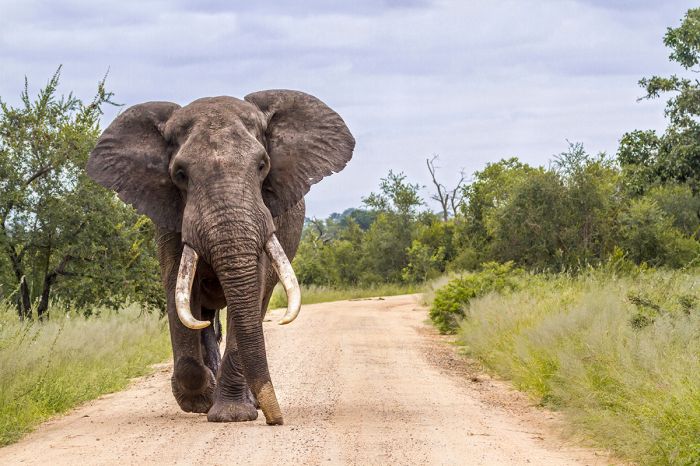
Elephant on the road in Kruger National Park
Africa's Big Five animals (lion, leopard, elephant, buffalo and rhino) can be seen here, as well as all the iconic species including giraffe, zebra, crocodile, hyena, cheetah, hippo, kudu, impala and more.
Besides the superb wildlife safaris offered in Kruger and the adjoining private reserves, the region includes the spectacular Blyde River Canyon (the world's third-largest canyon and part of the Drakensberg Escarpment), as well as several of the country's most historic towns - all within close proximity to one another.
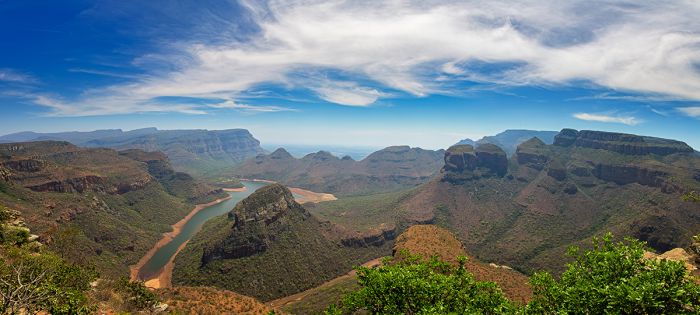
Blyde River Canyon and the Three Rondavels
The region straddles the South African provinces of Mpumalanga on the south and Limpopo in the north and is spectacular for its combination of scenery and wildlife.
Self-drivers can easily access all destinations here by road from Johannesburg. The popular and scenic Panorama Route passes through several quaint historic towns and though the Blyde River Canyon, which includes waterfalls and numerous spectacular lookouts.
(Blyde River Canyon is covered in detail here)
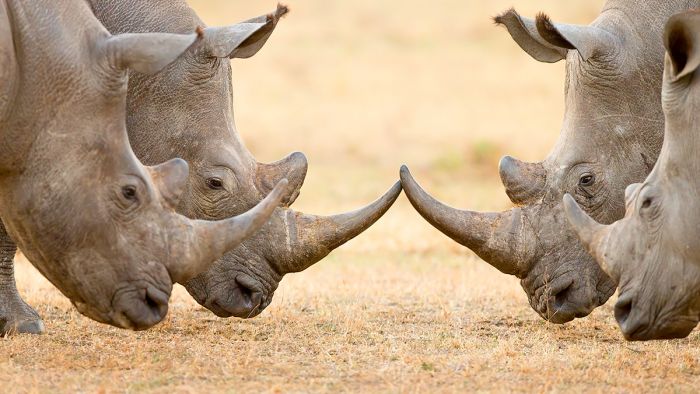
White rhinos in Kruger National Park
Read More...
Blyde River Canyon, Drakensberg, Dullstroom, Graskop, Hazyview, Kruger National Park, Kruger Private Concessions, Kruger Private Reserves, Nelspruit, Pilgrim's Rest, Sabie, Visiting Kruger, White River
Kruger National Park
In 1926, the Kruger National Park was officially proclaimed as South Africa's first national park. Many years later, in the the 1940's and 1950's, the privately owned land on the western border of the national park organized into private wildlife reserves with a more up-scale, less crowded approach to safari tourism.
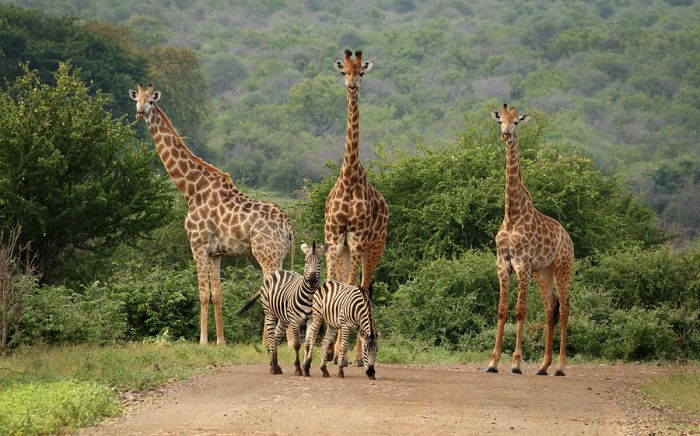
Giraffes and zebras on a road in Kruger National Park
Most of the national park is open to the public and is visited mainly by self-drivers, who traverse its 7 523 sq miles (19 485 sq kms) on a network of mostly tarred roads in search of animals.
VISITING KRUGER
How one chooses to visit Kruger and go on a safari depends mostly on your budget. The cost and style of a Kruger safari varies widely.
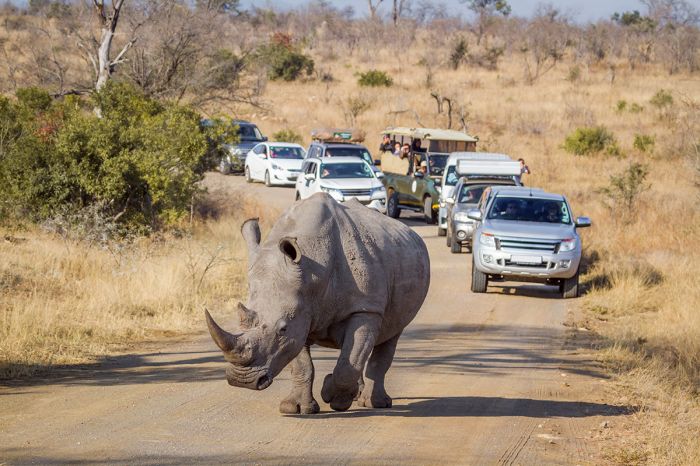
White rhino on road in Kruger National park
1. The most affordable option is driving yourself in a rental car and staying at one of the simple, self-catering bush camps inside the national park.
Staying inside the national park means you are sharing the roads (some of them paved) with other self drivers, no off-road driving, and likely some crowded vehicle situations if you are fortunate enough to have a sighting near one of the roads.
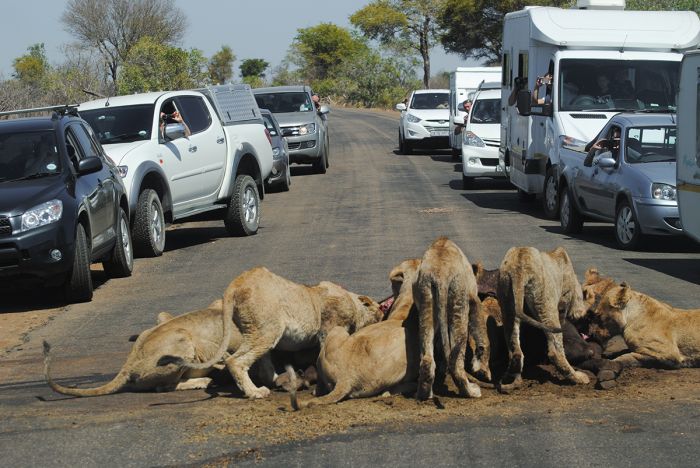
Lions on a buffalo kill in the Kruger National Park
2. A step up from self-driving is staying at a lodge outside the park in one of the nearby towns or inside the park at one of the lodges offering meals and optional guided game drives. Self-driving is also an option at these accommodations. Guided safaris at these lodges may mean a large vehicle or minibus with numerous guests on your safaris.
3. The high-end option is to stay in one of the private reserves that border the national park to the west or in one of the private concessions inside the national park.
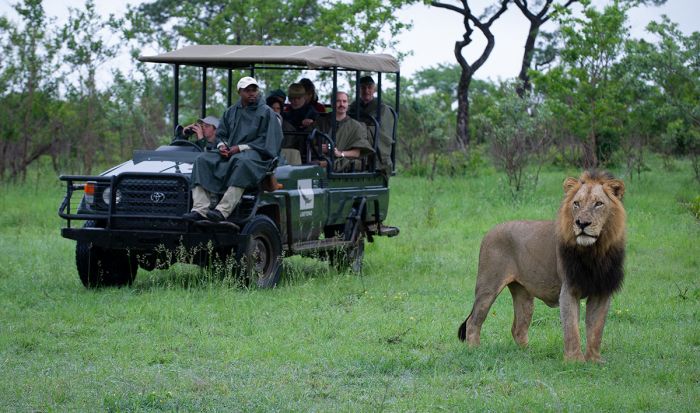
Game drive in a private reserve bordering Kruger (Copyright © James Weis)
This option offers expertly guided game drives in small 4WD safari vehicles (max 6 guests per vehicle), exclusive game drive territory (with no crowds), off-road driving access, night drives, chef-prepared meals, and up-scale accommodation offering a high level of service.
Wildlife in Kruger includes all the major iconic species like giraffe, zebra, elephant, buffalo, and both black and white rhino. Other herbivores include impala (the most common antelope by far), bushbuck, greater kudu, nyala, reedbuck, waterbuck, blue wildebeest, sable, warthog, steenbok, duiker, and klipspringer.
Kruger's predators include lion, leopard, Africa wild dog, spotted hyena, both black-backed and side-striped jackal, cheetah, and serval. Hippo and crocodile are found in the major rivers and larger pans and waterholes. Birding in Kruger is outstanding, with a list that tops 500 species and avid birders can easily tick off 100 species on a good day.
Kruger Private Reserves
Directly west of Kruger National Park are numerous privately-owned wildlife reserves, known collectively as the Kruger Private Reserves.
These reserves are connected to Kruger and the fences that once existed to separate them from the national park were taken down in 1993, allowing the wildlife to move freely in the large combined ecosystem.
The private reserves are only accessible to guests staying at one of the lodges and the safari experience here is far superior to that of self-driving and staying inside the national park.
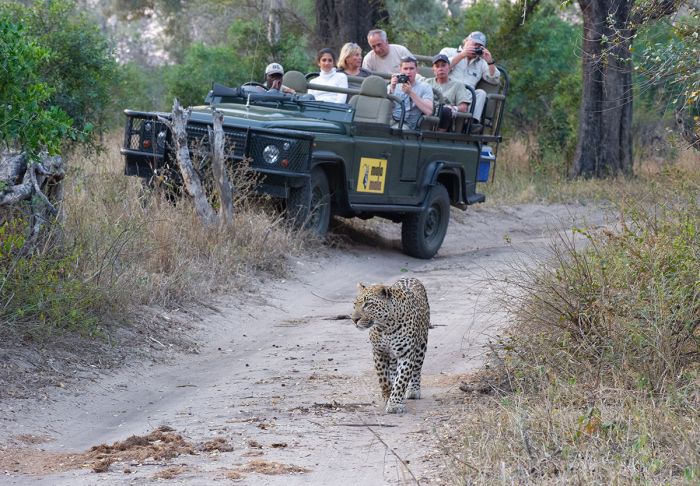
Leopard sighting in a private reserve (Copyright © James Weis)
Guests are taken on game drives in open 4WD game vehicles by expert safari guides and can even follow wildlife like leopards, lions and other animals off the sand roads and into the bush to follow them as they go about their lives (off-roading is not permitted in the national park). Further differentiating the safari experience from that of the national park are night drives and safari walks.
The lodges in the private reserves offer an exceptionally high level of service, with restaurant-quality meals, daily laundry, and drinks and snacks on game drives.
Well-known reserves include the Sabi Sand, Timbavati, Manyaleti, and Thornybush. Popular safari camps include MalaMala, Singita, Londolozi, Sabi Sabi, Ulusaba, Kings Camp, and Tanda Tula.
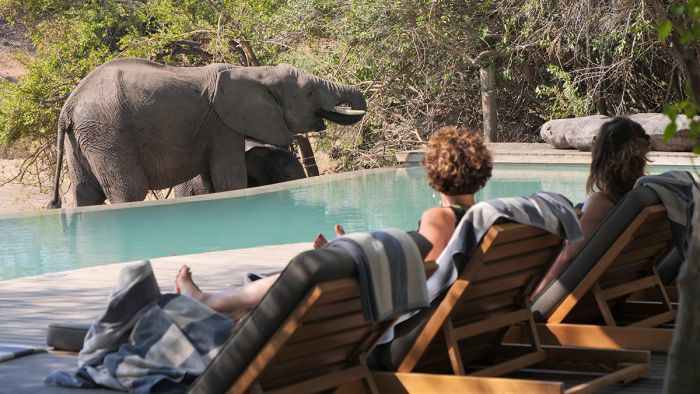
An elephant viewed from safari camp pool, Timbavati Private Reserve
Kruger Private Concessions
Within Kruger National Park are a number of private concessions that are similar in concept the the private reserves that adjoin the national park on its western boundary, except that the land is leased by safari operators from the national park authority.
The concessions include sizable and exclusive-use land, only two or three luxury lodges per concession, and general visitors to the national park are restricted, so game drives in these concessions are free from self-drivers and the crowds one may encounter in the majority of the park.
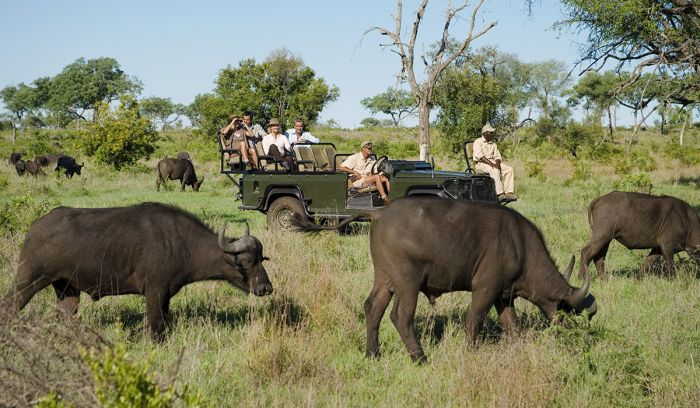
Kruger private concession game drive
Guests staying at one of these lodges enjoy guided game drives with private access to the land inside the concession, but are also free to venture into the rest of the national park if desired. Other advantages include off-road driving within the concession (to follow a leopard for example) and after-dark night drives to look for nocturnal animals.
The Singita Private Concession is located on the eastern border with Mozambique in the Lebombo mountains and offers huge concentrations of animals and two luxurious safari lodges.
The Pafuri Private Concession is located in the extreme northern tip of the national park bordering Zimbabwe and Mozambique. It is the largest and most remote private concession in Kruger and offers the best birding in the park.
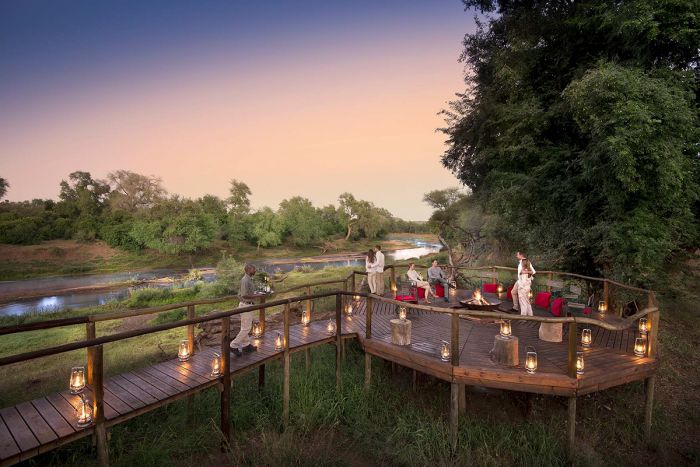
Evening at Pafuri Camp (Kruger private concession)
Tinga Private Concession is located in the southern section of the park, just across the Sabie River from the Sabi Sand Reserve and offering some of the best wildlife in the park. The area is well known for leopard, lion, spotted hyena, and wild dog.
Blyde River Canyon
Blyde River Canyon, the world's third largest canyon, is set in the Drakensberg Mountains escarpment some 50 miles (75 kms) west of Kruger National Park. The canyon spans 16 miles (25 kms) north to south, and averages 2 461 feet (750 meters) in depth.
The Blyde River Canyon Nature Reserve protects the land in and around the canyon. South Africa's Panorama driving route passes through the reserve as well as several historic towns. Pouplat attractions include Bourke's Luck Potholes, God's Window, the Three Rondavals, Lisbon Falls, Berlin Falls, and Mac Mac Falls.
(Blyde River Canyon is covered in detail here)
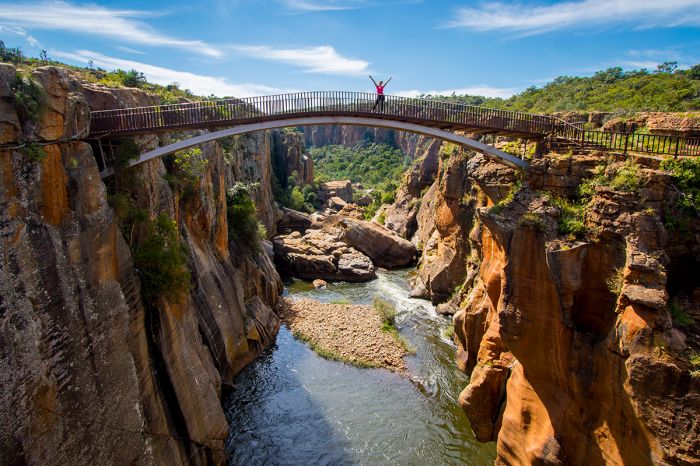
Blyde River Canyon
Notable towns
Nelspruit (Mbombela)
Now called Mbombela in the new South Africa, Nelspruit is the capital of the Mpumalanga Province and is considered the gateway city to Kruger and the lowveld. Surrounded by an prosperous agricultural community which farms citrus, tobacco, subtropical fruit and vegetables, this modern city has a population of around 60 000.
Kruger Mpumalanga International Airport (KMIA) services the city and the region, but visitors can also drive from Johannesburg in around 5 hours. The Lowveld Botanical Gardens and the Jane Goodall Institute's Chimp Eden are worth a visit.
Hazyview
Hazyview derives its name from the heat haze that hovers over the banana plantations and bush lands that surround this interesting little town. It is the center of tourism for those that choose to stay outside of Kruger and is located with easy access to the national park (Phabeni, Numbi or Paul Kruger gates), as well as being an easy drive to the Blyde River Canyon.
Hazyview offers numerous accommodations and restaurants and adventurers can try horseback riding, river rafting, hiking, ballooning, golf and more. The Shangana Cultural Village (an authentic Shangana village) offers tours, curios, meals and more.
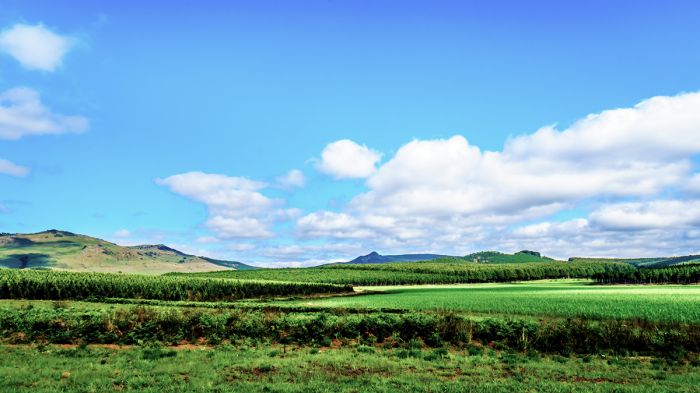
Pine tree plantations along R538 between Hazyview and White River
White River
White River is another quaint little town surrounded by tropical fruit and nut farms and conveniently situated between Nelspruit and Kruger. The town offers easy access to the national park and is an easy drive away from Blyde River Canyon. The town retains a colonial feel (it was settled by retired British officers in the early 1900s) but with a modern feel as well.
Pilgrim's Rest
This popular tourist stop is a national monument and dates back to the 1870s gold rush, when it became the country's first official gold mining town. The gold here is long gone, but the charming (although a bit touristy) village remains and is definitely worth a visit. Take one of the historic tours to see the beautifully restored houses, the cemetery, and any of the various museums.
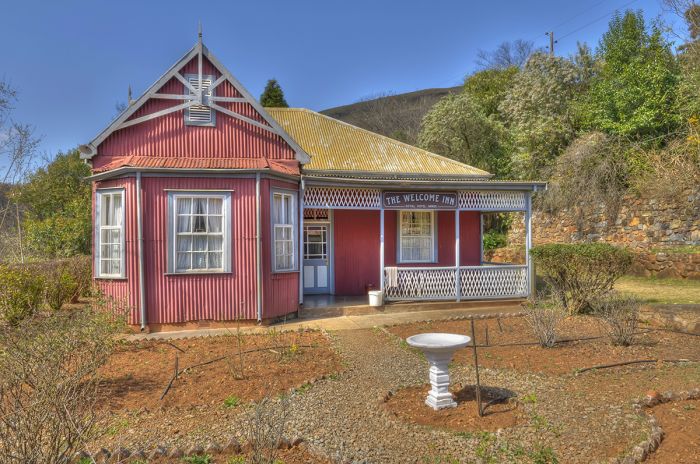
Restored hotel in the historic town of Pilgrim's Rest
Sabie
Sabie is a very enjoyable town which dates back to the gold rush of the late 1800s. Today the town offers plenty of restaurants, bars and shops. Sabie is a forestry town, sitting amid one of the world's largest man-made forests. The forests of pine and eucalyptus were planted in 1876 to supply the gold mines in the region with wood struts and posts.
The nearby Mac Mac Falls are part of the Blyde River Canyon Nature Reserve and are a spectacular sight to behold.
Dullstroom
Dullstroom has the well-earned reputation for having South Africa's best fly-fishing, specifically for trout. The town itself offers wonderful English pubs, restaurants offering the locally caught trout, cool, fresh air, fishing (of course), golf, and horseback riding,
Anglers can enjoy days of fresh country air here and the local fly-fishing operators will supply bait and tackle. The Dullstroom Birds of Prey Rehabilitation Centre is also worth a look.
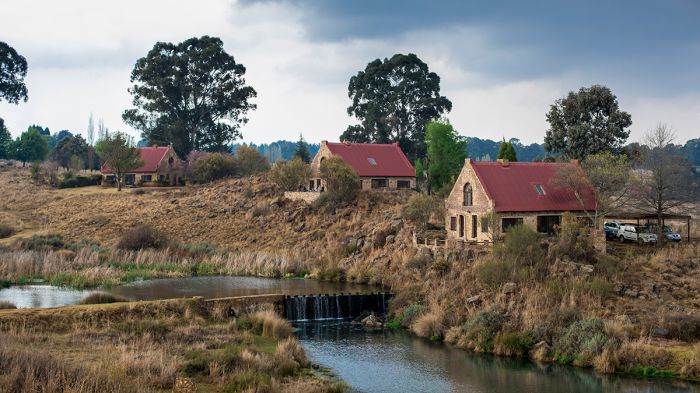
Fishing cottages in Dullstroom, South Africa
Graskop
Named for the abundant grasslands around this little town, Graskop is located along the southern end of the Blyde River Canyon Nature Reserve and is an excellent base from which to explore the area. Like most of the towns in the region, it started out as a gold-mining camp in the 1880s. After the gold dried up, the town remained as a railroad link for the timber industry.
Drakensberg Escarpment & Mountains
The Drakensberg (meaning Dragon Mountains) are the highest mountain range in Southern Africa and have some of the country's most beautiful scenery.
The Berg is a hiker's paradise, with endless gentle slopes, myriad valleys and high peaks, some of which top 10 000 feet. The range is a major watershed for the region, with two of the country's major rivers, the Orange and the Kugela forming here.
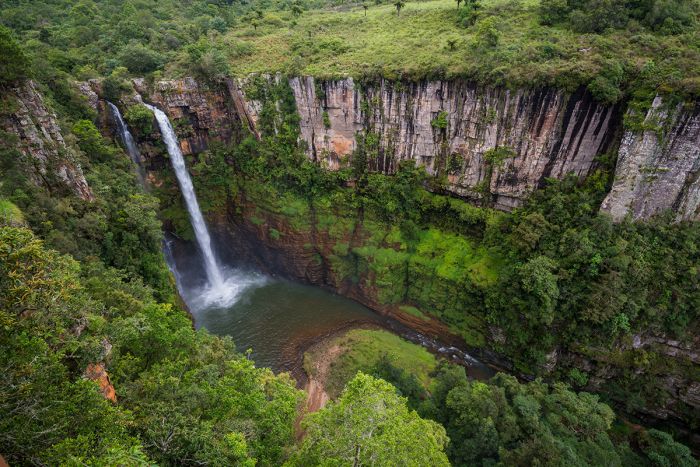
Mac Mac Falls in the Blyde River Canyon Nature Reserve
The Berg is a World Heritage Site, having been recognized for its natural and cultural significance, with some of the world's finest rock art as well.
Traditional touring is not possible in the Berg due to the limited road network, but there are some excellent lodges located in the lowlands and one can hike and explore this lovely and wild wilderness for days without seeing another soul.
Read More...
Blyde River Canyon, Drakensberg, Dullstroom, Graskop, Hazyview, Kruger National Park, Kruger Private Concessions, Kruger Private Reserves, Nelspruit, Pilgrim's Rest, Sabie, Visiting Kruger, White River
Kruger and Safaris
Great Good Fair Poor
- Jan
- Feb
- Mar
- Apr
- May
- Jun
- Jul
- Aug
- Sep
- Oct
- Nov
- Dec
Kruger National Park (and the adjoining private reserves) offer year-round wildlife viewing. The animals in Kruger do not migrate although they do roam between the private reserves and the national park.
The summer in this region is warm and humid, with rainfall occurring between November and March. The heaviest rainfall is between December and March, and these late summer rains can disrupt a safari, especially in heavier rainfall years.
The winter in Kruger is cool and dry and this means the wildlife may be concentrated near the permanent rivers or at pumped waterholes, as water in the bush and rain pans becomes scarce.
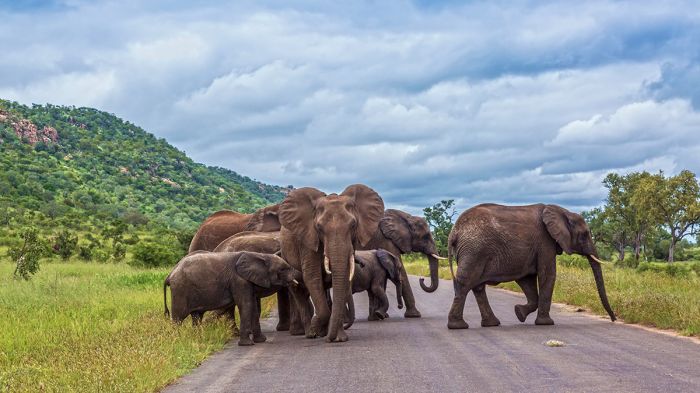
Elephants in the green, summer season in Kruger National Park
Spring and Summer
Spring and summer bring rains to the region and the recently brown and dry winter landscape changes into a lovely, lush paradise once the first few rains have fallen, usually sometime in late October or early November.
Wildlife viewing remains good even after the rains start to fall and the photography is excellent, with dramatic skies, baby herbivores in abundance and colorful scenery.
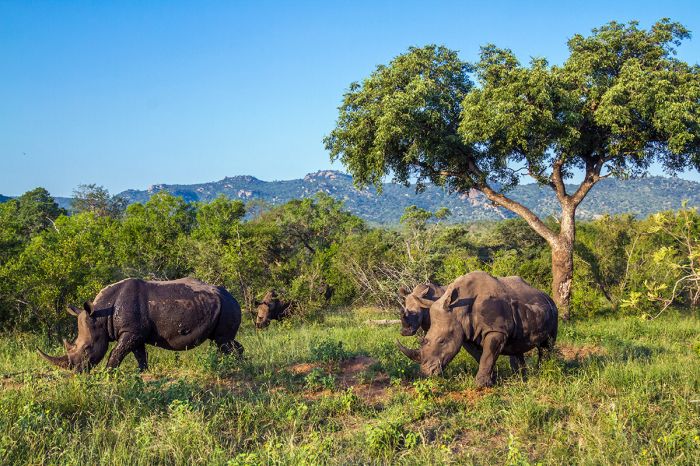
White rhinos in the summer season - Kruger National Park
The heaviest rains fall from January to February.
The earliest rains typically arrive as afternoon showers in late October or early November. These showers pick up in frequency as the weeks pass. Morning temps average 64°F/18°C and climb to 86°F/30°C by the mid-afternoon.
This time of year is spectacular in the Kruger region, with a verdant blanket of new grass and other vegetation in every direction, plus the arrival of migrant birds returning from the north that come here to nest. The wildlife viewing is good in spite of the occasional rain storms.
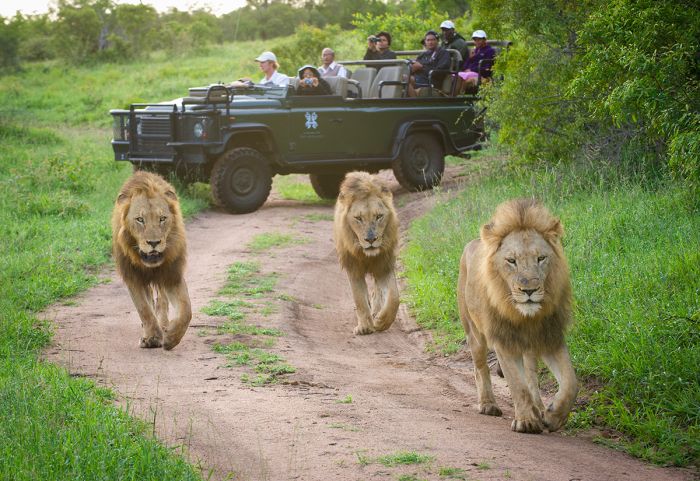
The green season and lions in one of the Kruger Private Reserves (Copyright © James Weis)
December thru February are much warmer and the humidity increases as well. Afternoons get very warm, averaging 88°F/31°C, but reaching 104°F./40°C on occasion. The ground is green and saturated and the trees are in full flower. Photography is spectacular. Herbivores such as impalas, warthogs and nyala have new babies, birds are fledging, and the bush is full of new life. Predators are eating well.
The rainfall tapers off during March and April, but showers still fall every few days, but with lessening intensity. The days are turning cooler, and temps are very comfortable, averaging 84°F/29°C during the day and falling to 64°F/18°C at night. The grass has grown tall, the bush is lush and thick and this means wildlife can be more difficulty to see. The migratory birds are leaving the area to fly north to their wintering grounds.
Fall / WINTER
The fall and winter months are cool and dry and the wildlife viewing is exceptional and it gets progressively better as the remains of the rain water in the pans and waterholes dries up and the animals are forced to stay near the pumped waterholes and permanent rivers.
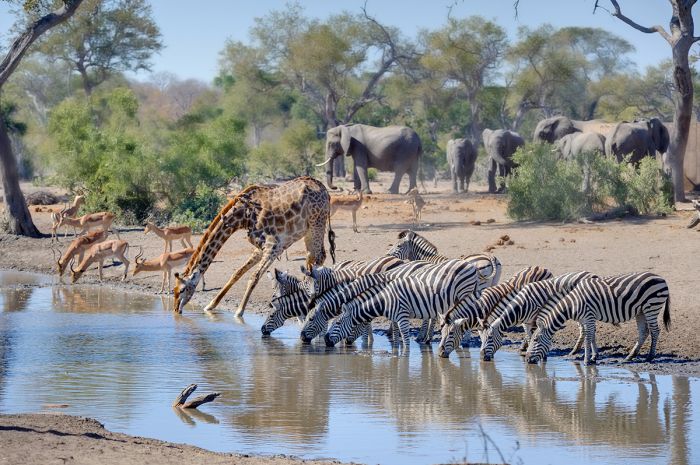
Wildlife visits a waterhole during the dry winter season in Kruger National Park
Warmer clothing including winter hats and gloves are recommended for the early mornings and dress in layers that can be shed as the daytime temperatures climb.
April and May are the autumn months and the temperatures are steadily falling, with mornings averaging 54°F/12°C and afternoon temps reaching 79°F/26°C. The rainfall is ending and the landscape begins the process of drying and turning brown.
June, July and August are the winter months and rains are rare. Mornings can be very chilly, with temps around 48°F/9°C. The afternoons are cloudless and sunny, with temps around 77°F/25°C. Game drives are very productive, especially along the rivers that still have water and at pumped waterholes, where the animals come to drink.
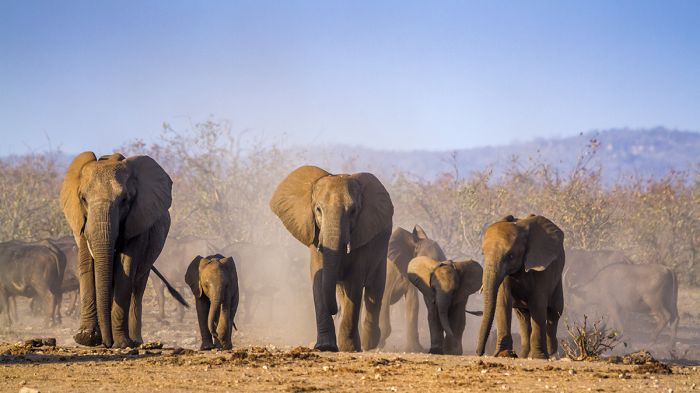
Elephants and dry landscape in Kruger's winter season
September is always a prime game viewing month and the air temperatures are very comfortable, making it one of the busiest times for tourist numbers. Rainfall is a very rare occurrence. Daytime temps are pleasant at around 82°F/28°C in the afternoons and 57°F/14°C in the mornings. Safari lodges are usually completely full and pricing reflects the high demand.
Drakensberg
Great Good Fair Poor
- Jan
- Feb
- Mar
- Apr
- May
- Jun
- Jul
- Aug
- Sep
- Oct
- Nov
- Dec
Springtime (September/October) and late fall (late April through June) is the best time to visit the Drakensberg.
Summers (November thru February) are lush and green, but also wet and hot, with afternoon thunderstorms very common on most days.
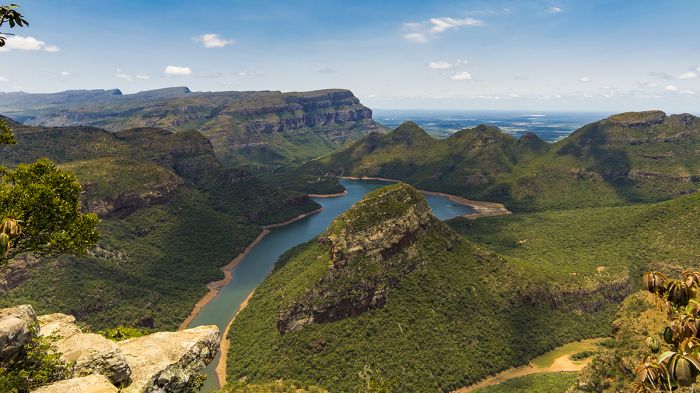
Blyde River Canyon in the Drakensberg Escarpment
Showing 1–2 of 2 results
Singita Lebombo Lodge is located in the Singita Private Concession in Kruger National Park. There are only two lodges and guests enjoy exclusive use of this wildlife-rich area in the foothills of the Lebombo Mountains.…




